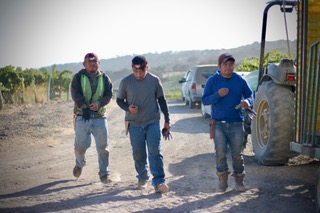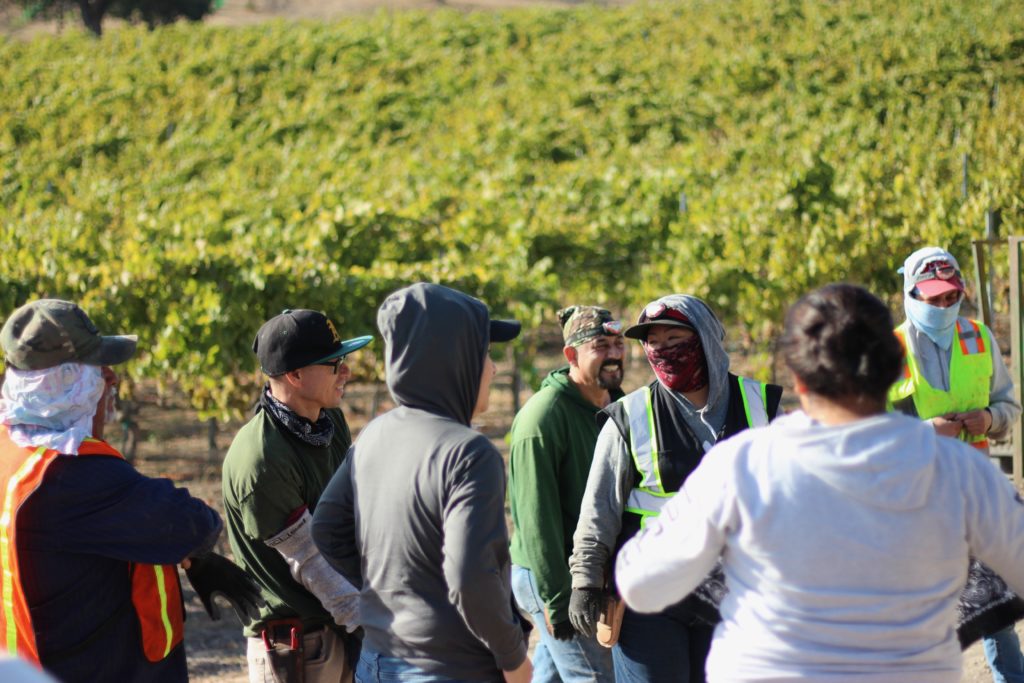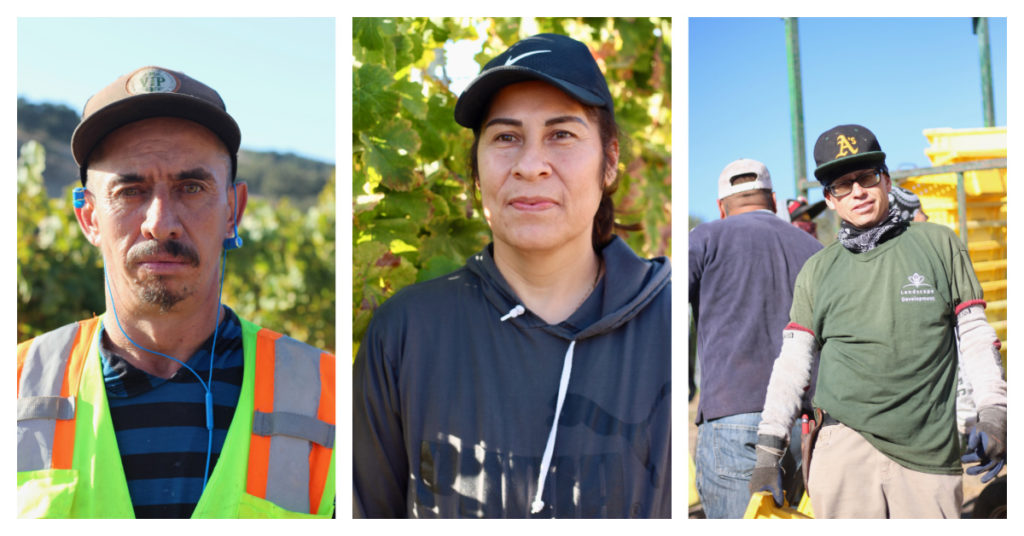If you are here, there’s a good chance you already make an effort to avoid nasties in wines and other products you consume — pesticides, chemical additives, unsustainable farming or production methods… you know the drill.
All of these have been sexy selling points for natural wines, with loyal drinkers proudly touting their favorite producers’ no-till farming methods or zero-zero approach to winemaking. Make no mistake — if it’s better for the planet and better for your health, we’re all over it. But until recent controversies came to light, the human side of wine production was largely left out of the sustainability conversation.
As an agricultural product, wine requires a LOT of labor. From planting to pruning to harvesting, even if a producer utilizes modern mechanization techniques, they’re still left with a need for skilled vineyard workers, especially at key points of pruning and harvest. Because of this intermittent need, many producers use contracted vineyard worker groups. In California, many of these groups consist of migrant, immigrant workers.
We rely on migrant workers for the delicious wines they help farm, but also for much of the produce we consume as the basis of our diets. They are, in every sense, essential workers. But if the pandemic has shown us anything, it’s that all too often the people we truly depend on are not treated as such. Agricultural workers in particular, due to a lack of full protections by the Fair Labor Standards Act (FSLA), can be subjected to lower-than-minimum wages, unhealthy working conditions, and other exploitations by employers.
It is imperative, now more than ever, that we dig into the human side of our favorite wines, and ask how our favorite producers create sustainable work environments, not just vineyards. We wanted to know what an alternative to the existing labor system could look like for wine producers and for workers, so we took a deeper look at Stolpman Vineyards.
Situated in the Pacific-cooled Ballard Canyon, just northwest of Santa Barbara, Stolpman Vineyards is renowned not only for their lush Syrahs and carbonic reds, but for their atypical approach to vineyard work. The family-owned and operated winery employs a year-round team of workers, and longtime lead vineyard managers, Ruben and Maria Solorzano, are business partners of the winery.
It sounds like a model that should be the norm, rather than an exception, so we spoke with Jessica Stolpman to learn more about the Stolpman model and how it delivers long-term benefits to the workers and the winery alike.

(Interview edited for clarity and brevity)
Q: The Stolpman Vineyard team is called La Caudrilla, which (besides sounding rad) translates to “group,” ”team,” “squad,” or “gang.” What does La Cuadrilla mean to you, and to the greater Stolpman team?
A: A lot of our team is from Jalisco, where “cuadra” means “block,” as in the land or place that you take ownership and pride in. A lot of farming is pretty repetitive work, so it can be easy to lose that sense of pride and energy when you’re doing these long, physical tasks. We combat that by giving our team direct ownership in what they’re doing.
Q: What makes the operation of La Cuadrilla different from the vineyard management of other wineries?
A: We’re lucky enough to be able to employ our vineyard workers year-round, which really contributes to a sense of ownership in the vineyard and in the community. It was a goal of Tom Stolpman to employ year-round, rather than employ contracted migrant work, because he was aware of the potentially negative impacts a lack of stability was having on migrant workers and their families. Tom wanted to know the people who worked for him and he wanted to be able to know his dream of starting a vineyard impacted everyone involved positively
Our lead vineyard managers, Ruben and Maria Solorzano, have been with us since 1994, and they’re really the ones making La Cuadrilla happen. Ruben set aside a block of land to train his crew on every aspect of grape growing and winemaking, having them make their own farming decisions and their own wine with what they had grown. The first couple years, the grapes were overcropped, and the wine wasn’t as high quality. The crew got to see firsthand why we take so much pride in each step of the process, like pruning or leafing, and that helped build a real understanding of why we do what we do. Maria gets the crew together on Fridays to cook together, eat together, and they drink wine — that’s something that’s really unique. We have our vineyard team also drinking the wine and sharing it with their families.

Q: How does involving your vineyard team in their own projects deliver benefits to those workers, and the winery overall?
A: For a few years, La Cuadrilla did some winemaking from their own grapes they were growing. Now, they’re focused in the vineyards, but we are still making wines under the name “La Cuadrilla” that directly benefit our team. We have 174 acres of vines, 10% of which goes into the “La Cuadrilla” Cuvée, and all of the profits from that wine go straight to the team. We have a big party every year where we get everyone together and hand out the bonuses from the La Cuadrilla sales, with the workers who have been with us the longest and have helped train younger team members getting the most. But aside from the monetary benefits, involving the team also creates more positive morale overall, a better work ethic, and happier workers.
Q: Have there been any unforeseen or indirect benefits of managing the Stolpman vineyards in this way?
A: We’ve definitely seen this way of doing things generate a lot of goodwill. It touches so many people in the community. Also, to grow the best grapes and make the best wine, we need the best people. These workers are very interconnected within their communities, and having a positive reputation as an employer has helped us attract great team members that also take pride in what they do.
Q: What are some of the ways that Stolpman Vineyards supports sustainable labor practices in other areas of the winery?
A: We have an incredible team at our tasting room in Los Olivos — just incredible. It’s been amazing to watch how during Covid everyone has put their heads down and worked so hard. Two of our tasting room team members are returning winemaking interns, which we really pride ourselves in — this continued education and building of knowledge across all areas of the winery. We get together for a full education seminar every quarter, with the team where we taste all the wines, eat together — it’s not just about showing up to work, it’s taking pride and ownership in what you do every day.

Q: What do you think is the single greatest barrier to other wine producers adopting a model similar to La Cuadrilla?
A: One of the things that allows us to support a year-round vineyard team is the fact that we’re growing a huge number of varietals — our harvest is up to 3 months long! For most other wineries, it’s closer to one month, sometimes even less. Our harvest is even extended a bit more, since [the grapes for] carbonic [fermentation] get harvested early, like our Sangiovese.
Most wineries use contracted labor, which is partly also a factor of scale — we’re a medium-boutique winery, so we have the volume to be able to grow our own grapes and also sell a small amount of fruit to buyers who believe in and want to support our system.
Also, other wineries just don’t have a Ruben and Maria. They’re our partners, they live on the property, they have ownership of their own vineyard, and their level of community involvement and recognition is huge. We have a reputation, but theirs is way bigger. And they’re the ones making this happen, managing and recruiting the team.
Q: Can employers alone create the solutions that will end exploitative labor practices in wine production?
A: There is only so much we can do as employers right now, but I’d encourage everyone to really take a look at the context of where everyone is as a part of your community — your vineyard workers, your other employees, everyone. In our county, access to mobile-proactive healthcare has been a great development and we’d like to see that continue to grow. But in the end as employers, the best thing we can do is give someone direct ownership and pride in their work.
Sources:
https://www.stolpmanvineyards.com/







No comments yet.